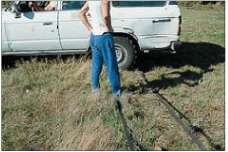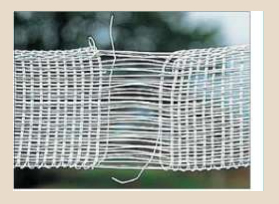Fence Maintenance
Check your fence regularly!
Electric tape fence also has weaknesses! It is so efficient that once it is installed you are inclined to think that all your fencing problems are solved. The most important ways to make sure fences are secure is to check them regularly for trouble spots. Use a fence tester to check your fence and check the voltage on a regular basis to ensure at least 6000 volts (optimally 8000 volts) on the fence line.Leave the power on
Without power your fence is just a tape fence, and after eating the grass under it without getting zapped, the horse will soon realise there is nothing to keep him from leaning further and further out, ultimately breaking the tape. So leave the power on at all times to keep your horses safe.
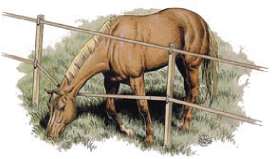
Broken connections
- Check your fence tape and the connections regularly to discover and fix the problems before your horses get loose.
- Keep the fence tight and re-stretch it if necessary, the wind flutter can break the wire conductors in a sagging tape.
- Look for broken insulators and broken tensioners. If any, do not hesitate to replace them. Inferior and cheap insulators that don't maintain the tape properly will end up cutting the wire conductors making the electric fence ineffective.
The charger is not operating
- Check the batteries - the batteries might need to be changed and often it is so obvious, it doesn't come to mind.
- Check the fuses. If they are blown replace them. If they blow instantly, the charger has to be serviced where you purchased it. Make sure that you have selected the charger with the maximum energy for your circumstances. The impulse energy has to be more than 1 Joule output for small fences and more than 5 Joules output for long ones
Do not attach the tape directly to the post!
The electric tape fence should not touch anything, including vegetation, metal or wooden posts, apart from the insulators, tensioners and insulated posts.
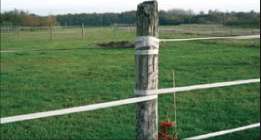
Weed control
- Don't forget to always turn the charger off before servicing your fence.
- Regular mowing underneath the tape is a good method. A horse that leans over or through a weak fence may loose respect for it.
- Use a powerful fence charger that can sustain power even with such losses of power.
- Install the tape high enough above the ground but low enough for horses and ponies not to creep under it. A happy medium is somewhere between 50 cm and 70 cm . Keep vegetation away by mowing or once a year, use a weed killer.
Clean your fence when necessary
It is difficult to avoid bird droppings and spider webs along the fence line. Birds may run along the fence, and their droppings are so acidic that eventually it will eat through the stainless steel threads. One solution is to use fibreglass posts to reduce invitation for birds to perch. Spider webs can be removed easily, but there will be less spiders along the fence with a good weed and local shrubbery control.
Ground rod
Check the dampness of the ground. About 90 percent of all electric fence problems are due to poor grounding. When the ground is frozen or too dry changing the electric connections between the charger and the fence is recommended.
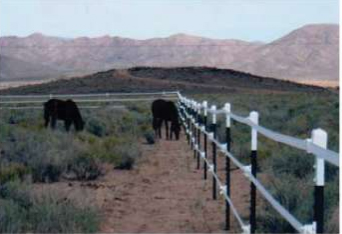
Storms
- Although your fence charger is usually protected with a fuse, it is always better to turn off the fence when there is lightning or an electric storm. Lightning is a major cause of fence-charger failure.
- Immediately after a storm, inspect your fence to make sure it is in good shape. A fallen tree might have flattened your fence, opening up an escape route before you realize it.
- In the event of a broken tape, release enough tape from tension to allow slack and use the splicing buckle #24 to reconnect the ends together.
A fault in the tape
Even though we have nearly doubled its diameter (0.5 millimetres) sometimes the weft threads break. The weft thread is the vertical thread in the tape that binds the 44 steel and polyethylene filaments of the tape. This is not very serious because the other wires are not cut. Although not as appealing in appearance, it doesn't alter the functionality of the tape. You can cut off the small portion of tape tape splice it back with a F24B buckle.
A metal object a few inches from the tape is electrified
The object may be a metal gate, a barbed wire fence or metal bucket. Please be cautious and aware of this possibility: The reason is that in dry weather conditions, the electrons can circulate about 30 centimetres around the tape. A metal object close to the fence and all the parallel wires can become electrified. The solution is to ground these metal objects by driving individual ground rods 51 centimetres in the soil.
Driving over the tape
Simply take the tape off two or three stakes and lay it on the ground. Put your foot on a stake or post (not on the tape) and then drive over it. Your tyres will act as insulators. This method can provide access with a vehicle carrying materials for fencing additions, etc.
